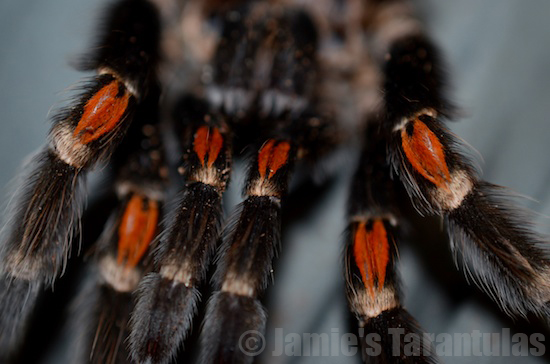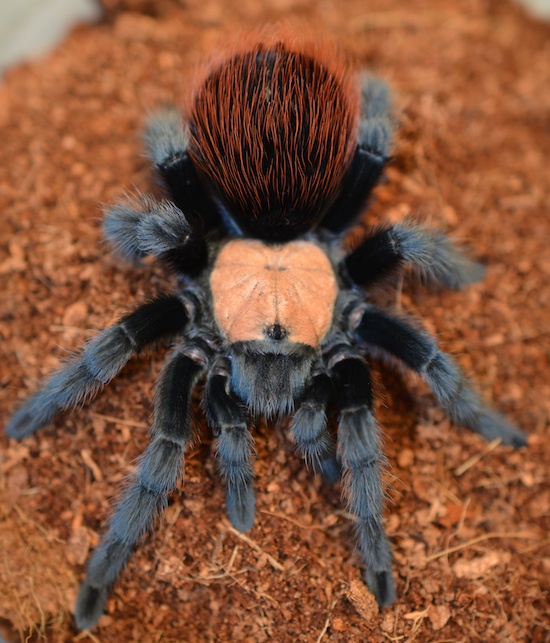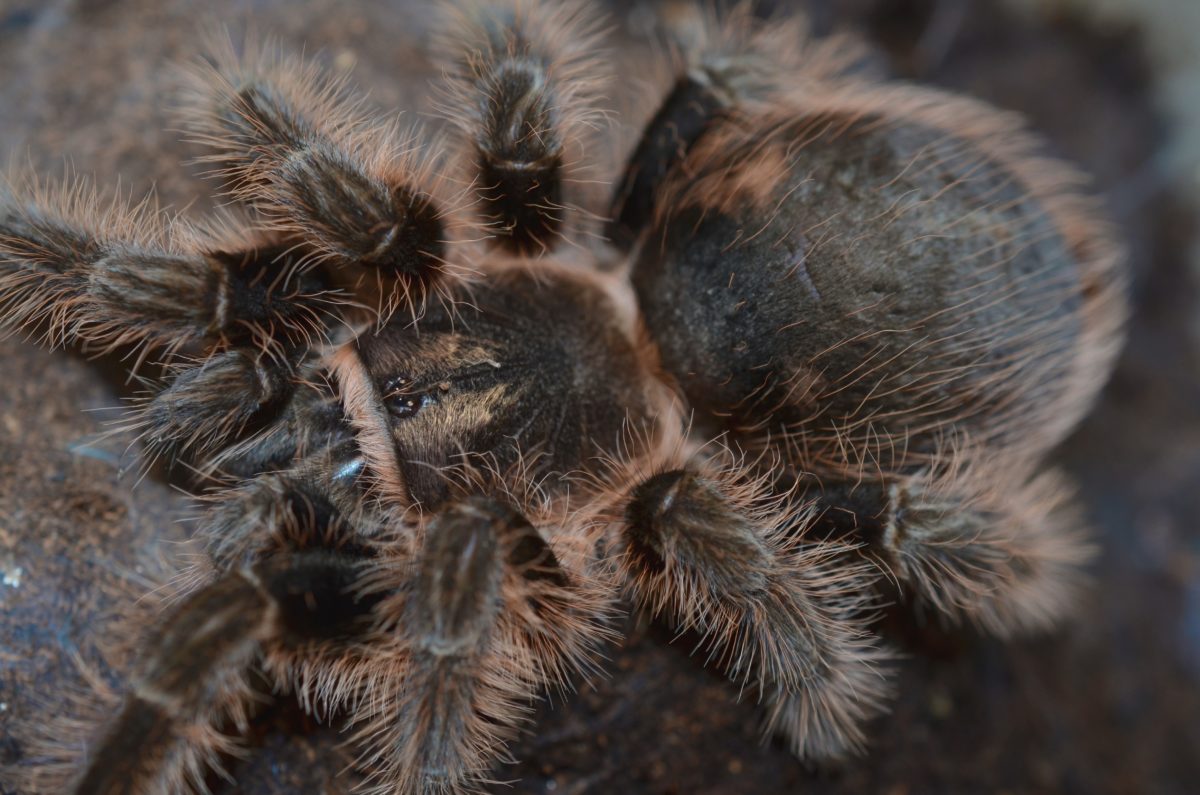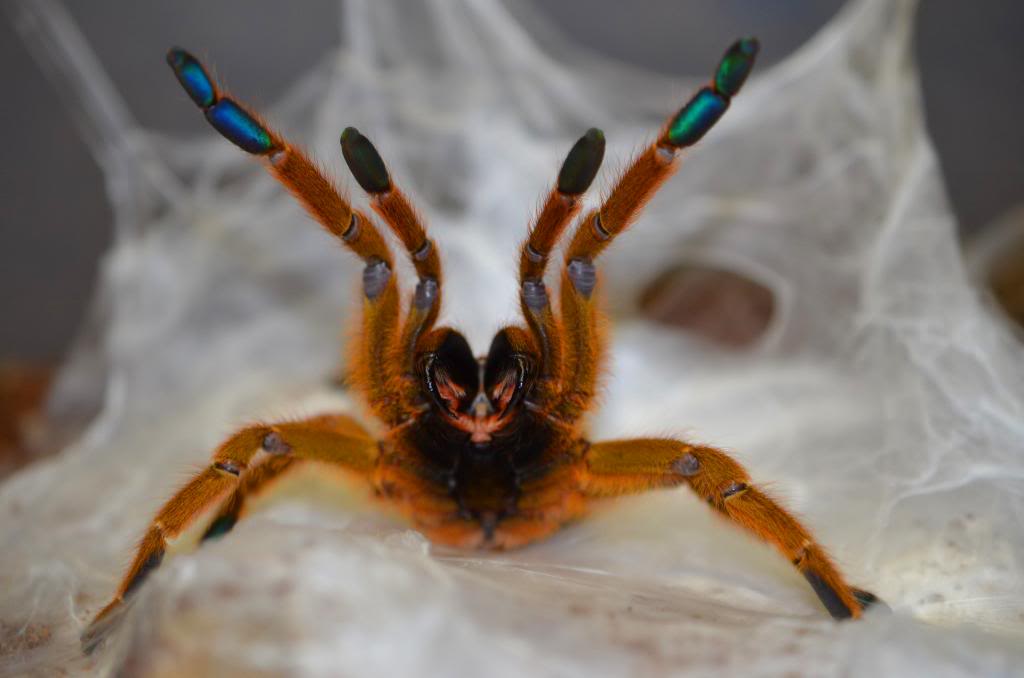Why should I order from Jamie’s Tarantulas?
Want you to be happy with your order and are work very hard to do so! I, Jamie personally hand select & pack every single tarantula we ship.
We strive for superior quality and service and combined have more than three decades experience keeping over two hundred different tarantula species! We are not a pet or reptile shop selling tarantulas, Tarantulas are our specialty!
To give our tarantulas the best possible diet we feed our roaches a blend of personally & locally grown, unsprayed (better than organic) produce, grains, bee pollen and other select ingredients… all to raise the healthiest and happiest tarantulas possible.
Jamie’s Cages were developed and originally built for our own use keeping and breeding tarantulas. We refined the design until satisfied and still use our own cages for the majority of our personal collection. To this day all Jamie’s Tarantulas brand enclosures are made right here in the USA.
We stand by our live arrival guarantee 100%, provided we are contacted with photo evidence in the timeframe set forth in the Sipping and LAG terms.
What are your shipping and LAG terms?
Our most up-to-date shipping and live arrival guarantee information and terms can be found HERE
What does shipping cost?
We ship flat rate, no matter what you buy. Our flat rate shipping options and guarantee for each is detailed on our: Shipping & Live Arrival Guarantee/TOS Page
The only two current exceptions to the flat rate shipping rule are the adult cages as they ship on their own, separate of your “flat rate shipping” order. As adult cages ship separate of the rest of your order their “free shipping” cannot be applied to other items.
Where do you ship to?
We ship tarantulas to the contential US and Alaska, weather permitting. We cannot ship tarantulas or feeders to Hawaii, US islands/outlying territories however, we can ship you supplies & cages provided your mailing address is within the USA/islands/outlying territories.
We cannot ship B. lateralis and B. dubia to Florida.
We are sorry but we can not ship internationally at this time.
What’s your shipping schedule?
Please note we ship according to our schedule, choosing expedited methods will only reduce the time your package spends in transit. Our regular shipping schedule is as follows. Orders placed:
Wednesday through Friday will ship Monday
Saturday and Sunday will ship Tuesday
Monday and Tuesday will ship Wednesday
Our current schedule including updates due to holidays and/or closures can be found HERE
Where are you located? Where do you ship from?
Our warehouse & tarantula facility is located in Aguanga, Southern California.
What about store pickup? Do you offer tours?
Tours and store pick-up are not available at this time.
Do you offer wholesale?
Brick and motor pet stores with a current business license (as a pet store) please email us for the current wholesale list.
What if it’s cold or hot?
Heat packs, cool packs, evaporative cooling, insulated boxes, and any other packing supplies needed to get you your order safely are included for no additional charge!
For the consideration of the live animals in your order, if weather that might delay shipment (snowstorm etc.) is forecasted please let us know in the order notes. We are happy to hold your order until weather improves!
We will check your temperature forecast the day your order is scheduled to ship. If we think weather is too hot and/or cold to get to you safely even with the special packing we will contact you.
We ship assuming someone will be available to immediately take the shipment indoors.
What is your live arrival guarantee?
Standard shipment for one hour after arrival. This means we need to be contacted within one hour of delivery with clear, photo evidence of the DOA(s), to be covered.
Signature shipment is guaranteed for 48 hours provided it was signed for on the first attempt. This means we need to be contacted, with photo evidence, within 48 hours of arrival, and the package needs to be signed for on the first attempt for the DOA to be covered. If no one is immediately available to sign for the package the carrier may (at their own discretion) sign for the package and leave it in a secure location. In this instance the live arrival guarantee is the same as standard shipping, we need to be contacted within one hour of the carrier leaving the package for LAG.
Hold for pickup: Is live arrival guaranteed provided we’re contacted the same day the package arrived at the pickup facility.
What if my tarantula or feeders arrive dead?
We stand by our guarantee 100%, provided the Live arrival guarantee (LAG) terms are followed and we are contacted in the timeframe stated above.
Why one hour for non-signature shipments?
If we ship your order the live invertebrates should be fine provided someone is able to take it indoors right away. We would highly advise against leaving your package out in the elements as we have done countless tests with insulated packing to insure we are shipping the best way possible. We’ve found insulated boxes shipped with heat packs, cool packs or evaporative cooling methods tend to do fine while in transit when they’re buffered from the elements however, when left in the elements such as in on a porch or driveway, in a recepticle etc. after nearly an hour the little box with it’s travel-size heater or cooler can’t keep out all of Mother Nature’s wrath. Such neglect can and will result in fatalities. We ship assuming someone will be available to immediately take the shipment indoors as customers agree to the live arrival guarantee (LAG) terms upon checkout.
We want your tarantula to arrive safe, and in the rare case it doesn’t we want you to be covered under our live arrival guarantee (LAG) so please be absolutely sure your understand and agree to our live arrival guarantee policy before placing an order. Please be there for your live animal(s) safety and if you have any questions or concerns don’t hesitate to contact us before ordering.
What if the package experiences a carrier delay?
Once we leave the package with the shipper it is literally out of our hands. We prepare each shipment for extra time in transit as every so often we have a delay and they have certainly been more common as a result of COVID-19 and other current events. No matter how long it takes to deliver we offer the same live arrival guarantee, as long as the LAG terms are followed.
When on a truck there is a buffer to the elements. The only thing we can’t prepare for is the package sitting on a hot or cold doorstep so if possible have someone home to receive the box and always plan for a possible delay. Despite a delay the shipment is usually fine provided it’s properly received.
Whether it’s on time or delayed please be sure to contact us within the timeframe specified in the LAG terms to receive your free replacement, credit or refund in the very rare case of a DOA.
How do I track my package?
Tracking will be emailed to your the evening your order ships.
When you place an order please provide a valid email address and double check it is correct as this is the address we will use to email your tracking number.
Why does my tracking number say “invalid”, “not found” or “no such number”?
Tracking will display one of these, or a similar message until it’s first scanned in. The packages typically get scanned between 2-10pm PST the afternoon/night the order ships.
How do I sign up for text and/or email alerts?
Once the tracking link is active (scanned in) you can sign up for tracking alerts via your tracking number/page.
Can you sign me up for text and/or email alerts? Can I receive a call or text when my order is out for delivery?
The only way to receive a text or email when your package is out for delivery is to sign up for email and/or text alerts via your active tracking link. Due to sensitive user agreements we cannot sign customers up for alerts on their behalf at this time nor can we personally sign up for alerts of every package we send and call/text each customer when the package is out for delivery (especially considering one can very easily sign up for this automated service via their tracking link)
Also, be aware the carriers delivering the package cannot be relied upon to call or text when the package is out for delivery (nor can they or we be held responsible for resulting complications if they don’t!)
We highly recommend signing up for the email/text alerts! It’s super easy to do, just follow the instructions in your active tracking link and don’t hesitate to contact us with any questions!
Remember, if tracking is not yet active you’ll have to wait for it to become active before you’re able to sign up for alerts.
Can I provide an alternate address in case no one is home?
Our carriers do not offer this service at this time.
What if I have a guard dog or my home/complex is gated? What if I live in a complicated apartment complex?
Please make sure you can receive delivery as scheduled to the address provided otherwise, we recommend requesting “hold for pickup” in the order notes upon checkout.
What if the package is stolen?
Once the package is delivered to the the address provided upon checkout it becomes the responsibility of the recipient. Carriers are equipped with GPS tracking so when a package is marked delivered the exact location is recorded. This is how we can distinguish and locate misdelivered from stolen packages.
What is the gender? Can I choose the gender?
If the gender is known it will be stated in the title. If there is no gender stated in the title the specimen is sold as “unsexed” as we do not know the specimens gender at this time.
We are unable to determine or guess as to the gender of unsexed specimens. Thank you for not asking us to “pick a probable female” etc.
How is gender determined? Why can’t you determine the gender of small tarantulas?
Visit THIS PAGE see how gender is determined, and understand why we can’t determine the gender of small tarantulas at this time.
How do you measure?
Visit THIS PAGE to see how we measure our tarantulas.
How do I read a tarantulas ad?
Tarantula ads read in the following order: scientific name, common name (if applicable), size (measured in inches diagonal leg span), gender (if known, if unsexed no gender will be stated), and number (If applicable) For example: Chilobrachys fimbriatus (Indian Violet) 3-3 1/2″ FEMALE #E-5
What does the number at the end of the tarantulas ad mean?
I hand pick every tarantula on my website. I won’t post it for sale unless it’s the correct condition for shipping, healthy, free of obvious blemishes and has recently taken prey with vigor. The number is used to help me identify a specific tarantula, or group of tarantulas by shelf, bin or individual enclosure. If you’re contacting us regarding a specific tarantula please include it’s reference number if it has one. This way I know which specific tarantula to refer to.
Is a tarantula a good pet for me?
Tarantulas are one of the lowest-maintenance pets available, but this doesn’t mean they can’t be neglected. Tarantulas have specific needs and although these needs are very simple to meet, they are often not what pet owners are used to. Please do your research and don’t assume! Each species and even each specimen will have it’s own preferences regarding husbandry. Make sure to check on your tarantulas at the very least every few days and be ready to meet their needs if necessary. Watch their behavior and adjust care accordingly. This could be as simple as a light mist if the enclosure has dried a bit, keeping it away from a sunny window, leaving the tarantula alone and withholding food if it’s locked in it’s home, giving it some quiet time to itself etc. Keep in mind over-care (such as flooding the enclosure with feeders if it’s not hungry) can be just as dangerous as neglect (such forgetting to mist the enclosure for an extended period of time)
Provided it’s basic needs are met a tarantula can be a very rewarding low-macitence pet.
What about the temperature in my house?
Any tarantulas listed in the beginners section will be comfortable at “room temperature” This means if you’re comfortable in a T-shirt the tarantula should be alright. For Most Grammostola, Brachypelma, even GBB this means temperatures of 70 and up with occasional, seasonal and/or nightly drops into the 60’s are typically not a concern. In cooler weather tarantulas tend to slow their metabolism and won’t be as active or hungry as they are in the warmer months. Be aware some (more advanced) species such as A. purpurea will typically require higher temperatures to be content.
Water?
Please note tap and/or well water can contain chemicals that might be harmless to humans but can cause trouble for the little tarantula. I have seen DKS result in using tap and well water and strongly recommend against it. We use RO water for all our tarantulas.
Humidity?
Many new keepers try to maintain humidity as a specific number. I would not advise doing this. Use your temperature and humidity gauge to measure the area near the enclosure(s) and help provide our tarantulas better care. When it’s warm and dry (low humidity) the enclosure will dry out more quickly, and will require more frequent misting and depending in the situation maybe even a heavier mist. If it’s cooler and humid we know we should probably have a light hand misting, the enclosure won’t dry out as quickly.
Misting?
The substrate should be subtly moist (somewhat dependent on the species) and the trantula should have “dew” to drink off the sides on the enclosure a few times a week. There is a bit of a learning curve when it comes to misting. Gardners and those with a green thumb tend to get the hang of it pretty quickly as the concept of “not too wet or dry, a few times a week” is already habit.
We recommend new keepers mist one corner of the enclosure. This way the tarantula can choose between moist and dry substrate and the new keeper can adjust based on the tarantulas preferences.
What about a Water Bowl?
Tarantulas under about 2-3″ don’t need nor do we recommend using a water bowl. Once the tarantula is large enough it can be given a shallow, wide dish in order to drink from.
What enclosure and/or feeders should I get for my tarantula?
We should have enclosure and feeder recommendations in the description of every tarantula for sale. Click on the name to visit the tarantulas individual page. If you don’t see the enclosure or feeders recommendations its possible I overlooked that ad, please let us know they’re missing I will amend the website with this information asap!
Can I keep the tarantula in the container it was shipped in?
The vials we ship in are great for shipping, not for housing.
What about cleaning the enclosure?
We highly recommend a pair of tweezers to aid and weekly maintenance and feeding. Remove any uneaten food or organic matter that might mold or invite pests into the Tarantulas enclosure. There is NO need to change the substrate unless it becomes unsanitary. This typically only happens due to mold, as a result of too much moisture allowed in he enclosure for too long.
Can I get more information on Feeding?
Visit THIS PAGE for more information on feeding tarantulas.
We detail the feeder types, sizes, and conclude with a troubleshooting guide.
Handeling?
I consider Tarantulas observational pets although many people (including my own mother) think otherwise. When I first got into the hobby I did purchase my first tarantula thinking I would handle, but quickly realized the stress it caused the C. versicolor. Handling not only stressed the little guy out, it often resulted in damage to it’s home and put it at unnecessary risk of injury or even death.
Also, at first I didn’t notice the urticating hairs, however I quickly developed a reaction to them. Being itchy for a day or two after handling made it even less appealing.
Tarantulas are not domestic animals and will often act unpredictably. I do not handle my specimens except when absolutely necessary in the case of emergency typically as a result of packing, rehousing, breeding etc. We do not recommend handling for the safety of you and your tarantula however, many owners still purchase with handling in mind.
If you wish to go against our recommendation and handle your specimen please do so at your own discretion. We advise testing the specimen with a soft paintbrush to determine if it’s in a “bad mood” before contact is made. Please do everything possible to reduce the risk of injury from a fall. Grammostola and Brachypelma species are typically the most popular “docile beginner picks”. Beginners should chose only amongst the New World tarantulas. Old World species should never be considered for beginners or handled for any reason.
Special considerations:
Keep your tarantulas enclosure away from a sunny window. Even just a few minutes in the sun can cause a greenhouse effect in the enclosure, causing the temperatures to soar to dangerous and sometimes deadly heights. Tarantulas don’t like vibrations and will appreciate being away from speakers or other things that might cause semi-content or constant vibration or movement. Be sure if you have dogs or cats you only use high-quality, natural essential oils to control fleas and ticks. Products such as advantage, flea collars, flea spray, etc. can be dangerous or deadly. Tarantulas are very sensitive to pesticides and can have issues from crop dusting, a neighbor tenting for termites etc.
Can I keep them together?
The short answer is NO, you will end up with one big fat tarnautla but… there are a few exceptions, with a few species, under a few select circumstances. One should not consider a communal (enclosure with multiple tarantulas) until they are intermediate to advanced keepers. If you’d like to learn more about communal tarantula set-ups we have check out the communal category for lots of information and photos on the subject.
I think I am ready for a tarantula, what do you recommend for me? I’m a beginner?
All my personal recommendations for beginners can be found in the beginners section. This lists all the beginner tarantulas we currently have available for purchase.
Currently the A. geniculata, G. pulchra, Brachypelma & Tliltocatl species are our current most popular beginner picks due to their temperament, ease of care, tolerance of a wide range of temperature, humidity, enclosure and soil types, vigor, appetite, interesting habits, longevity and how they change colors/pattens as they grow.
What are the most common beginner mistakes?
HERE is a list of our top 10 beginner mistakes, and how to avoid them.
I see my desired tarantula listed in your store. Do you have it in stock? We take great pride in the quality and accuracy of our inventory. We only list specimens on our website if they are currently in stock, healthy, vigorous and ready to ship and have an in-stock guarantee as our policy. Discrepancies only happen only a few times a year. On the very rare instance we don’t have the tarantula you purchased you get $5 store credit.
I don’t see it in your store. Do you have my desired tarantula(s)?
I am sorry, the only tarantulas we have available for purchase are listed in the store. I am apologize but we don’t have anything hiding in the back room, only available to those who ask nor can we predict when we’re going to have something available. Absolutely everything currently available for purchase is posted in the store.
I saw a tarantula in your store recently that’s no longer there. Do you have it in stock?
I am sorry, if the tarantula was there and is now gone this means we are sold out of this particular tarantula. We cannot predict when it will be back in stock.
How often do you get new tarantulas in stock?
I post new tarantulas one to three times weekly.
What are you going to get in stock in the near future?
This is one of our most asked questions and there is honestly no easy easy to tell customers that I have no idea. I simply cannot predict who is going to molt and when, if they will be big enough to determine gender, if I will be able to retrieve an intact molt and if so what gender they will be, if they will be blemish free and pass their pre-sale inspection. Even if we have an eggsac with momma spider we don’t know if it’s going to hatch and will not announce anything publicly or via email until we know for sure.
I promise as soon as I find something new that is healthy, vigorous, free of blemishes, correct shipping condition etc. I will immediately post it on the website!
How do I get notified of new inventory?
We currently announce on *facebook when we have over a dozen new additions within 24 hours.
I post 1-4 times weekly and do not announce if only a few new additions are available.
Our inventory is constantly changing we encourage you to check back often!
*We will soon be moving away from the facebook platform and begin announcing 12+ new additions at a time via the newsletter, to be sent no more than once weekly. We will sometimes include coupons and special offers for subscribers .
How do I sign up for the newsletter?
By becoming a member of the website or when you check out you can opt into the newsletter.
Do you offer freebies, coupons and/or discounts?
We occasionally send out special offers such as coupons, freebies & discounts to our newsletter subscribers. We don’t sell or give out your information and currently send a newsletter only a few times a year.
Is that the photo of the actual tarantula?
Unless stated the photo is a stock photo representing the species.
Can you get a photo of the actual tarantula?
Due to the unpredictable nature of tarantulas, the risk of injury (to the tarantula), the difficulty of getting them to pose and hold still long enough in good lighting for a clear photograph, the inevitable damage/destruction to the specimens home in order to extract it for the photos, the resulting stress to the tarantula (and myself… I often end up frustratingly itchy after a shoot…) We apologize but we are unable to accommodate individual photo requests at this time.
Do you hold tarantulas?
We are unable to hold with no or partial payment. We are happy to hold orders, prepaid un full, up to two weeks.
What payment methods do you accept?
Visa, Discover and Mastercard








